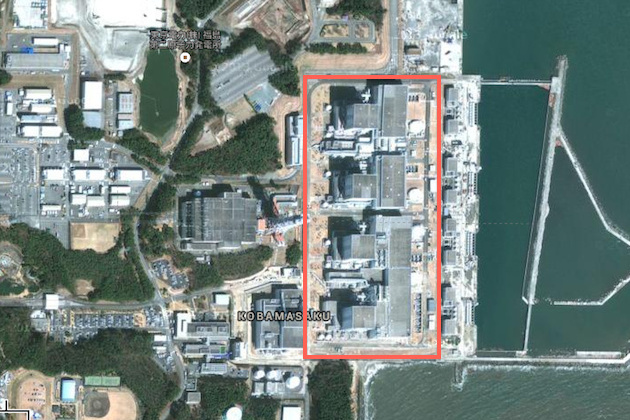A Google Maps aerial view of the four Fukushima reactors surrounded by Tepco's proposed dimensions for the ice wall
Japan this week announced its intentions to build an ice wall surrounding the damaged Fukushima nuclear plant. The hope is that this frozen barricade will keep leaking radioactive water from finding its way into the surrounding environment and the Pacific Ocean.
The problem for Fukushima is two-fold. One is dealing with fresh water that's continually pumped into the plant's reactor cores to keep them cool, water that's later stored on site in leaky tanks. That water is also at risk of leaking out through the main reactor site and entering underground systems.
The other problem is the fact that water flowing underground from nearby mountains can penetrate the Fukushima site. That water picks up radioactivity and carries it off elsewhere, which is both dangerous and difficult to control. But by freezing the ground underneath the reactors, officials hope to contain leaks and stop water from seeping in in the first place.
As Alexis Madrigal pointed out, this plan sounds like something out of a supervillain’s notebook or even some movie that Mystery Science Theater 3000 might mock. But ice walls have been used successfully for many years, especially in mining.
The general mechanics are pretty straightforward. It’s less about building an ice wall and more about putting the parts in place so they can grow.
Basically, pipes are implanted into the ground equidistant from each other surrounding the plant. Coolant within the pipes is chilled by a refrigeration unit and then pumped downwards into the ground. Once below the surface, the coolant absorbs heat form the surrounding soil. It then gets pumped back up, cooled again, and heads back down.
Eventually, as more and more heat is extracted, ice encircles the pipes. The space between them eventually becomes filled with ice, which converges into an frigid rampart preventing radioactive water from going where it shouldn’t.

MS Paint rendering of the Fukushima ice wall by Derek Mead
As you might imagine, this process moves along at a leaden pace, taking months for the ice wall to fully emerge. But once it does, it’s a pretty daunting obstacle for the radioactive water to overcome. Even if a leak were to open and water were to try make its way through, the liquid would quickly freeze and plug up the very hole through which it was trying to escape.
While the wall may be conceptually simple, there are snags elsewhere in the plan. Very real concerns exist about those involved in putting the pieces in place. People involved in the construction of the ice wall risk exposure to contaminated dust, as well as radioactive leaks. Furthermore, TEPCO, the power company responsible for the Fukushima cleanup, is not footing the $470 million bill for this. That honor, unfortunately, goes to the Japanese taxpayers.
